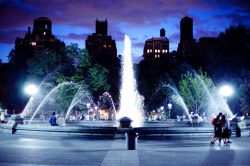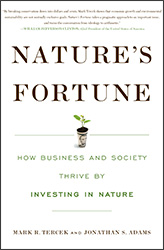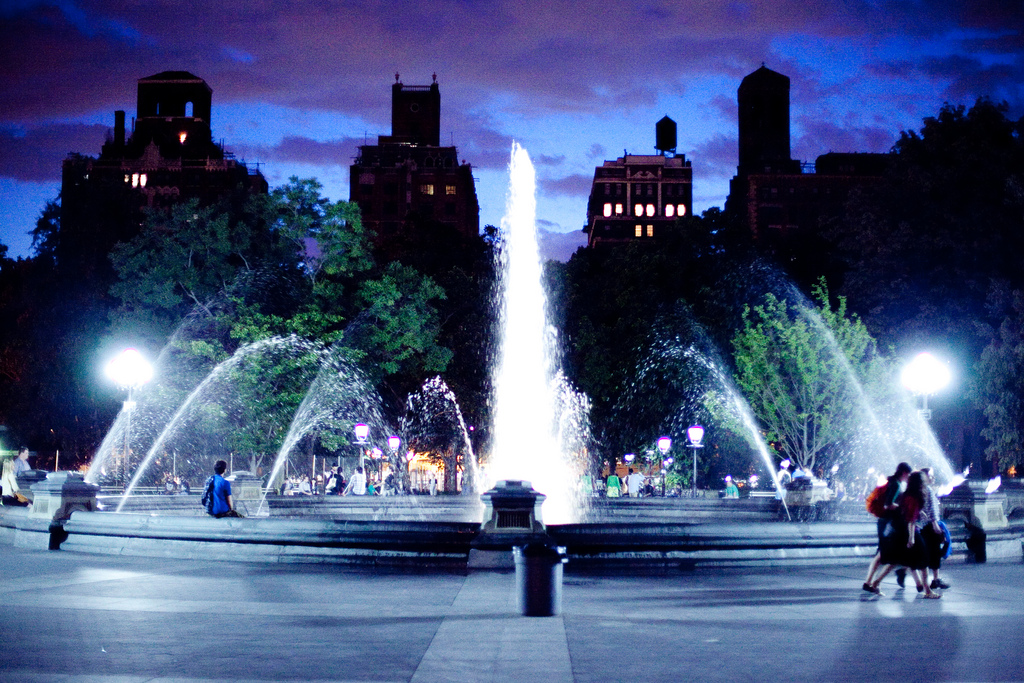
Ed SchipulWashington Square Park.
Eddie & Sam’s Pizza in downtown Tampa, Fla., boasts “Real New York Pizza.” The distinguishing characteristic of real New York Pizza? Not the crust, the cheese, the sauce, the toppings, or even the giant, floppy slices. It’s the water. Every few months, Eddie & Sam’s brings in 1,000 gallons of water from the same Catskill springs that feed New York City’s reservoirs. Another company, the Brooklyn Water Bagel Co., with about 20 locations across the country, has gone even further. Rather than import water from Brooklyn, the company seeks to recreate the precise chemistry of New York water through a patented 14-step filtration process, and only then can the water be used to make their bagels.
All that time, money, and technology to get just the right water for pizza and bagels may seem excessive, but New Yorkers take justifiable pride in their water. Most of New York’s supply never passes through a filter and receives comparatively small doses of chlorine and fluoride.
For their high-quality and lightly-treated water, today’s New Yorkers can thank quite a few forested hillsides and a handful of foresighted city planners. Though they did not put it in these terms, those planners invested in nature, and generations of New Yorkers have reaped the benefits ever since.
The city planners’ investment had particular urgency. Cholera outbreaks that spread through the city’s water in the early 19th century killed thousands of New Yorkers. These epidemics, along with water pollution and a quickly growing population, forced city officials to search the countryside for cleaner and more reliable sources than surface water and local wells. Even in 1837, New York officials, anticipating the city’s growth, invested in a system of aqueducts to bring water from the Croton River, east of the Hudson River and some 25 miles north of the city line.
By the end of the 19th century, population growth outstripped the capacity of the aqueducts from the Croton River. To supplement this supply, officials turned their attention to the Catskills, 2,000 square miles of hills and valleys west of the Hudson and three times as far from the city as the Croton. The region was still almost entirely rural. There were some farms, but forests were largely intact and streams clean-running. Construction of a system of reservoirs, tunnels, and conduits from this ideal water supply began in 1905.
 The system grew beyond the Catskills to include the Delaware River watershed, and by 1964, the entire system, the largest waterworks in the country, was complete. An engineering marvel, New York’s waterworks rely on gravity and little else to deliver 1.2 billion gallons of water every day through nine reservoirs, three lakes, 300 miles of tunnels, and 6,000 miles of distribution mains.
The system grew beyond the Catskills to include the Delaware River watershed, and by 1964, the entire system, the largest waterworks in the country, was complete. An engineering marvel, New York’s waterworks rely on gravity and little else to deliver 1.2 billion gallons of water every day through nine reservoirs, three lakes, 300 miles of tunnels, and 6,000 miles of distribution mains.
The system has worked well for decades, teaching us an invaluable lesson: With care, and absent catastrophic changes in climate, this system can provide clean water forever. Clever engineers have not discovered how to build dams and pipes that will never decay. Instead, they knew to rely on services that nature provides. Soil and tree roots filter water, microorganisms break down contaminants, plants in streams absorb nitrogen from automobile emissions and fertilizer runoff, and cattails and other wetland plants suck up nutrients while trapping sediments and heavy metals. Protect those services — which improve with age — and everything else is merely maintenance.

Nicholas A. TonelliThe Delaware River.
The Catskills watershed is a textbook example of what has become known as green infrastructure. In contrast to built or gray infrastructure, such as pipes and treatment plants, green infrastructure consists of woodlands and grasslands, wetlands and rivers. Networks of these natural lands, together with working landscapes such as farms, woodlots, and other open spaces, keep ecosystems functioning, provide wildlife habitats, and contribute to the well-being of human communities by filtering water, controlling floods, cooling and cleaning the air, and providing areas for recreation, among many other benefits.
In the choice between building new gray infrastructure and conserving the green kind, the latter option is often less expensive and more efficient. Consider the example of New York’s Croton River and Catskill watersheds. The largely suburban Croton lies within an easy drive of the city. The roads, parking lots, lawns, golf courses, and other elements of suburbia mean more pollution washing into reservoirs — fertilizers and other chemicals, trash, motor oil, tiny particles spewing from the exhausts of cars and trucks. This so-called nonpoint source pollution, the bane of freshwater ecosystems everywhere, is notoriously difficult to control.
By the late 1980s, New York officials gave up on fully controlling the pollution through such measures as improving septic systems and reducing erosion and accepted that they would eventually need a filtration plant for the 10 percent or so of the city’s water that flows through the Croton system. Construction took eight years and cost $3.4 billion; the plant began operations in 2012, and will cost millions more each year to operate.
Pollution remained far less of an issue in the Catskills throughout the 1980s and 1990s, but risks were growing as a result of changing economics of the region. Owners of small family farms and woodlots struggled to stay in business. Many turned to intensive agriculture in smaller areas, which increased runoff and soil erosion, or they built more roads to get more timber to sawmills. Others chose to sell their land to vacation-home developers, jump-starting even more road construction and the salting necessary to keep those roads open in winter. Pollution began to spike, with a risk of worse to come if development overwhelmed rural septic systems.
Many New Yorkers began to see a new filtration plant as inevitable. When the U.S. Environmental Protection Agency issued strict new rules for surface water in 1989, the city faced the daunting prospect of building an even larger filtration plant than that on the Croton River, at a cost of perhaps $8 billion. The owners of more than 800,000 buildings in New York City would end up footing the bill through increased water and sewer fees. The economic cost to the city overall would be enormous.
City officials, led by Al Appleton, commissioner of the New York City Department of Environmental Protection and director of the city water and sewer system, had another idea. Maybe instead of building a filtration plant, protecting the watershed would cost less and achieve the same, or better, results. To put a complex political, economic, and scientific argument in its simplest terms: If you can prevent pollution in the first place, then you won’t have to spend huge sums of money to clean it up later. Appleton and other city officials recognized that investing in nature, specifically the Catskills watershed, would pay a huge dividend: decades of clean water for New York City.
No one had tried this before — not at this scale. But with a multibillion-dollar project on the horizon, New York’s leaders made the leap. Through much of the 1990s, New York City, 60 towns, 10 villages, seven counties, the state of New York, the EPA, and environmental groups negotiated the terms under which the EPA would waive its filtration requirement and allow the city to avoid building the new plant.
They finally reached an agreement in 1997. That agreement limited growth in the watershed and committed the city to spend $1.5 billion to buy land, build storm sewers and septic systems, and upgrade existing sewage plants.
The brilliance of New York’s solution was that Al Appleton and other officials did not try to take on just one problem. They thought big. Rather than attempting to plug one source of pollution at a time — an approach that has failed repeatedly — the city worked with farmers to help them manage their land in ways that would allow them to meet their own economic needs while providing clean water downstream.
While the city has the power under state law to manage development in the Catskills, most land there remains in private hands. Conservation would have to be a cooperative venture. Unless the residents of the Catskills were behind this, New York City knew that enforcement of pollution standards from 100 miles away would never work.
The city began to pay for pollution control investments on each farm as an incentive for farmers to join. Instead of selecting a top-down menu of best management practices, farmers worked with city and state agencies to custom-design pollution control measures — such as building fences and bridges to keep livestock away from waterways — to maximize their effectiveness and minimize their cost. The resulting solutions were not only better and less costly at controlling pollution than previous efforts, they also saved farmers both time and money.
This realization turned the usual pollution dynamic upside down. Businesses and communities tend to resist new regulations, seeing them, rightly or wrongly, as burdensome. Far better, then, to engage these businesses and communities as providers of a valuable service to a willing market. Farmers now had a new crop to sell: water.
The city needs periodic approvals from the EPA, the latest issued in 2007 and lasting for 10 years. As part of that agreement, New York also committed to spend another $241 million for land acquisition over 10 years. In early 2011, the state issued New York City a permit to acquire 105,000 more acres in the watershed.
New York City has spent billions of dollars in the Catskills, a huge transfer of wealth from the city to the countryside. Those investments boosted the upstate economy with more jobs and businesses, from contractors to install septic systems and upgrade wastewater treatment plants, to jobs with the city and state, to new tourism enterprises. Catskills farmers, who had previously thought of the environment as something that forced them to spend money to solve somebody else’s problems, now made money by becoming environmentalists. For some, that extra income was the difference between selling out and staying on the land. More than 90 percent of the farms in the watershed participate in the program, putting about 75,000 acres under improved management.
The combination of protected lands and improved management of working farms enables New York to pull off a neat trick — a win-win-win. People in New York City get cleaner, more secure water; residents of the Catskills get paid for a benefit they have long supplied for free; plants, animals, and people benefit from more conservation. That last one can be tangible, too. Gretchen Daily sums it up in a question, and only partly in jest: “Would you rather spend a romantic weekend at a filtration plant or in the Catskills?”
Excerpted with permission from Nature’s Fortune: How Business and Society Thrive by Investing in Nature, by Mark R. Tercek and Jonathan S. Adams. Available from Basic Books, a member of The Perseus Books Group. Copyright © 2013.
Read our interview with Mark Tercek.



